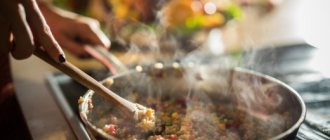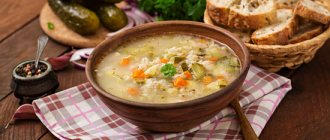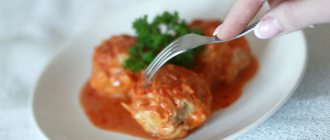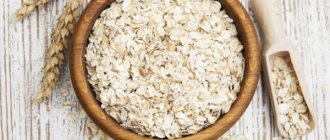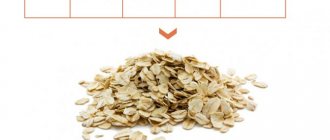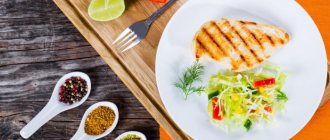How many calories:
=28 kcal.
Lenten vegetarian borscht with water without meat - 28 calories. per 100 grams.
Lenten vegetable borscht is an excellent dish for vegetarians and during fasting. Like all soups without meat and broth, vegetable borscht is a low-calorie first course. 100 grams of the product “Lenten vegetarian borscht on water without meat” contains:
- Potatoes - 10 g;
- Cabbage - 8 g;
- Beets - 8 g;
- Carrots - 4 g;
- Onion - 4 g;
- Tomato paste - 1 g;
- Vegetable oil - 1 g;
- Garlic - less than 1 g;
- Dill - 1 g;
- Water - 63 g;
Russian borsh
Let's look at the composition of borscht, because it has its own specific ingredients: beets, white cabbage, sautéed roots, onions and tomato puree, which can be replaced with fresh tomatoes. The first dish must be acidified, for example, with vinegar or cabbage brine, and sugar is added to it, which together with the acid gives the dish a sweet and sour taste. Borscht can be prepared with boiled or raw beets. It is chopped into strips, sprinkled with vinegar and sautéed in fat. The vegetable is processed so that it does not lose its beautiful burgundy color when stewed. Then add broth, sugar, tomato puree to the beets and, closing the lid, simmer over low heat. Young root vegetables are stewed for 30 minutes, and old ones - from one to one and a half hours. Some time before the end of stewing, you need to add sautéed roots and onions.
Separately, cook the meat broth, which consists of pulp and bones. It is salted only after it boils, as this improves the taste of the borscht base. It is important to skim the foam and fat from the broth several times, only then will it be transparent. It is cooked over low heat, otherwise it will have an unattractive appearance and the taste will noticeably suffer.
Fresh raw cabbage is placed in the boiling meat broth, and after boiling again, stewed beets with roots are added and cooked for about 30 minutes. At the end of cooking, add browned flour diluted with broth, spices, salt, sugar to the borscht and boil for ten minutes.
If sauerkraut, rather than fresh cabbage, is added to a dish, it is first stewed. You can cook borscht with boiled beets, then they are added in the same way as other vegetables. It is good to serve this dish with cheesecakes, krupenik or other dough products with filling. True, this will increase its nutritional value.
This recipe is used to prepare classic borscht. Its calorie content depends on the ingredients that are included in the composition. For example, if you replace beef with poultry, the dish will be easier to digest. The calorie content of borscht with chicken is an order of magnitude less than with other meat.
How to reduce the calorie content of borscht
Reducing the calorie content of borscht is quite simple
. Of course, the safest thing for your figure is soup cooked in water. Borscht cooked with bones or pork will, accordingly, have the most calories. The average amount of calories is contained in borscht cooked in chicken or beef broth. The recipe for Ukrainian borscht involves pre-frying vegetables. It is also worth considering that sour cream is added to it. Of course, all this increases the calorie content of borscht.
Adherents of a healthy diet solve this problem in the following way: they refuse to sauté onions, beets and carrots in vegetable oil and fat. Instead, they throw vegetables into a pot of boiling water, as a result of which they do not feel heavy even after a large portion of borscht.
Remember that beans can be an excellent substitute for potatoes. As for sour cream, you can replace heavy cream with a low-fat version - this will not affect the taste of the finished dish. Borscht is low in calories, so you can treat yourself to it several times a week
, and your figure will not suffer.
Ukrainian borsch
Let's look at Ukrainian borscht, the calorie content of which is found in the table below. Potatoes and fresh white cabbage cut into strips are added to the prepared broth. To prepare the dish, beets are stewed with onions, carrots, vinegar, sugar, as for the classic version. Vinegar can be replaced with lemon juice. Sometimes beets are placed in a dish separately, and onions and carrots are stewed along with bell peppers and tomato paste, which can be replaced with fresh tomatoes. Before finishing cooking the Ukrainian borscht, add black peppercorns, herbs, and bay leaves. Dill and parsley can be either fresh or dried - this will not deteriorate the taste of the dish. After the pan of borscht is removed from the heat, a few cloves of garlic are placed in it. This kind of borscht, the calorie content of which in its finished form will be about 90 kcal per 100 grams, is called Ukrainian.
Dietary borscht recipes
The calorie content of borscht prepared according to the classic recipe is 87 kcal per 100 g.
To prepare it, take 300 g of lean beef, 1 onion and 1 carrot, 2 medium potatoes, 1 medium-sized beet, 100 g of fresh white cabbage, 2 cloves of garlic, a bunch of fresh parsley, 1 tomato, pepper and salt to taste. Boil and strain the beef broth. In a small amount of water, simmer the chopped onions and carrots with garlic and tomato for about 10 minutes, then add the chopped beets. Chop the peeled potatoes and shred the cabbage. Place the stewed vegetables in the broth and place the pan on the fire. When the water boils, add the cabbage; after the next boil, add the potatoes. Boil the soup until the potatoes are ready, serve with herbs and low-fat sour cream.
The calorie content of vegetarian borscht is only 23 kcal per 100 g.
It is prepared in exactly the same way as in the recipe described above, but not with meat broth, but with vegetable broth.
For 1.5 liters of water you will need 1 beet, 2 potatoes, 300 g cabbage, 1 onion and carrot, 1 tomato, herbs, salt, pepper and sour cream with which you will serve this soup. If you liked this article, please vote for it:
(25 Votes)
“Borscht and porridge are our food,” says a popular saying. Indeed, this first dish has long gained popularity among millions of housewives. Today, borscht is so loved and entrenched in many families as a healthy, tasty, and most importantly affordable and easy-to-prepare dish that it has become practically an integral part of the menu of our population. So, what is included in borscht? This dish includes:
- cabbage;
- beet;
- beef or pork meat;
- tomatoes;
- carrot;
- garlic;
- pepper;
- Bay leaf;
- tomato paste;
- beans;
- greenery.
Today, no one doubts the benefits of such a first course; the questions that we increasingly receive are usually the following: “What is the calorie content of borscht?”, “Is it possible to lose weight with borscht?”, “I love borscht, does its calorie content bother me?” , “If you cook some borscht without meat, will its calorie content become lower?” “Please tell me how many calories are in borscht?” and other similar questions. We are happy to answer them. So…
Lenten borscht
Lenten borscht, or vegetarian, which is prepared in the same way as all others, but only without meat and in vegetable broth, is low-calorie. You can add beans to it, which contain vegetable protein, which increases the nutritional value of the dish. Let's calculate the calorie content of borscht without meat: in the lean version with beans there will be about 25 kcal per 100 grams, and without them - 23 kcal per 100 grams. However, vegetable broth does not impair the taste and does not harm the figure. That's why many women are interested in vegetarian borscht - the calorie content is minimal, and in terms of usefulness it is not inferior to the classic version.
Calorie content of borscht
Borscht is one of the hearty first courses because, as a rule, it is cooked in fatty meat broth. The number of calories depends on the recipe according to which it is prepared. First of all, you should pay attention to the ingredients included in the dish. Knowing them, you can easily calculate the calorie content of borscht.
Let's consider the number of calories in borscht of one type or another.
. Thus, a 100-gram portion prepared according to a traditional Ukrainian recipe contains about 100 kcal. The calorie content of borscht with fresh cabbage does not exceed 117 kcal, with sauerkraut – 156 kcal. The lowest calorie content is borscht with beans: 100 grams of the finished product contains no more than 67 kcal.
If you are striving for an ideal figure, but do not want to give up borscht, give preference to the least high-calorie versions of this soup. By the way, nutritionists advise eating slightly warm borscht - this will naturally reduce its calorie content.
Cold borscht
Cold borscht can be called okroshka in another way, because they are similar in the method of preparation. To prepare the dish, beets, potatoes, and eggs are boiled and cut into cubes. Cucumbers and herbs are chopped and added to the vegetable mixture. Boiled meat can sometimes be replaced with pork or beef tongue, sausage, sausages - then you get a “country” version of the dish. The main difference between cold borscht and okroshka is that it is prepared using beetroot broth, which gives it a beautiful color and original taste. Beetroot soup is often prepared in the summer, when the body has difficulty accepting heavy food. Everyone who is losing weight should cook cold borscht at least once - the calorie content of the dish is 72 kcal per 100 grams of dish.
Lenten red borscht with beans
| 1 | 2 | 3 | 4 | 5 |
Recipe description: Lenten red borscht with beans:
During Lent you always want delicious, hearty dishes. And this borscht will delight you with its taste and add satiety. It contains a whole “bouquet” of vegetables: beets, carrots, cabbage, potatoes, onions, and even beans, which are famous for their high protein content, the lack of which is especially felt during Lent. This borscht is also perfect for vegetarians.
Lenten red borscht with beans: composition, calorie content and nutritional value per 100 g
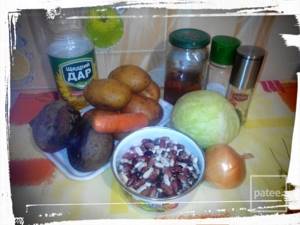
To prepare borscht we need beets, cabbage, potatoes, beans, carrots, onions, tomato sauce, sunflower oil, salt, pepper. And also a large saucepan for 5 liters.
Let's start with the beans, since they take the longest to cook. Pour the dried beans into a deep bowl and rinse thoroughly with water. Fill with clean water and leave for several hours (even overnight) so that the peel wrinkles as in the photo. Soaking will significantly reduce the cooking time of the beans. After this, rinse again and set to cook.
The beans need to be cooked for at least half an hour; the cooking time depends on the type of beans and the duration of soaking. Periodically you need to check the readiness of the beans to taste. There is one more sign

